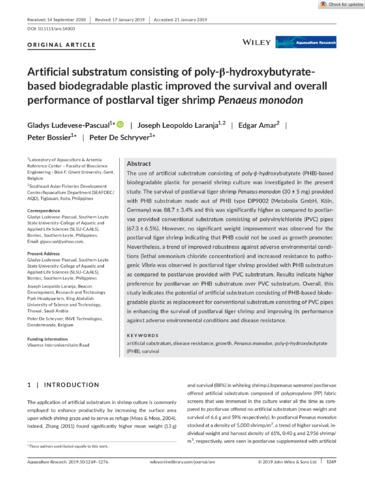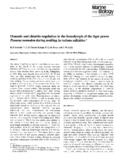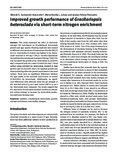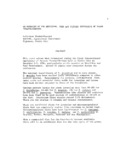Artificial substratum consisting of poly-β-hydroxybutyrate-based biodegradable plastic improved the survival and overall performance of postlarval tiger shrimp Penaeus monodon
Share
Abstract
The use of artificial substratum consisting of poly‐β‐hydroxybutyrate (PHB)‐based biodegradable plastic for penaeid shrimp culture was investigated in the present study. The survival of postlarval tiger shrimp Penaeus monodon (30 ± 5 mg) provided with PHB substratum made out of PHB type DP9002 (Metabolix GmbH, Köln, Germany) was 88.7 ± 3.4% and this was significantly higher as compared to postlarvae provided conventional substratum consisting of polyvinylchloride (PVC) pipes (67.3 ± 6.5%). However, no significant weight improvement was observed for the postlarval tiger shrimp indicating that PHB could not be used as growth promoter. Nevertheless, a trend of improved robustness against adverse environmental conditions (lethal ammonium chloride concentration) and increased resistance to pathogenic Vibrio was observed in postlarval tiger shrimp provided with PHB substratum as compared to postlarvae provided with PVC substratum. Results indicate higher preference by postlarvae on PHB substratum over PVC substratum. Overall, this study indicates the potential of artificial substratum consisting of PHB‐based biodegradable plastic as replacement for conventional substratum consisting of PVC pipes in enhancing the survival of postlarval tiger shrimp and improving its performance against adverse environmental conditions and disease resistance.
Suggested Citation
Ludevese-Pascual, G., Laranja, J. L., Amar, E., Bossier, P., & De Schryver, P. (2019). Artificial substratum consisting of poly-β-hydroxybutyrate-based biodegradable plastic improved the survival and overall performance of postlarval tiger shrimp Penaeus monodon. Aquaculture Research , 50(4), 1269-1276. https://doi.org/10.1111/are.14003
Subject
pipes; biodegradation; disease resistance; ammonium compounds; shrimp culture; survival; environmental conditions; substrata; ammonium chloride; plastics; pathogens; shellfish; aquaculture; biodegradable substances; weight; growth; Decapoda; Penaeus monodon; Artificial substratum; poly-β-hydroxybutyrate (PHB); Chloride resistance; polyvinyl chloride; ammonium; Polyhydroxybutyrate; biodegradability; Vibrio; Waterborne diseases
Taxonomic term
Collections
- AQD Journal Articles [1249]
Related items
Showing items related by title, author, creator and subject.
-
Osmotic and chloride regulation in the hemolymph of the tiger prawn Penaeus monodon during molting in various salinities
Ferraris, Ronaldo P.; Parado-Estepa, Fe D.; de Jesus, Evelyn Grace; Ladja, Jocelyn M. (Springer Verlag, 1987)The effect of molting on osmotic and chloride concentrations in the blood of the prawn Penaeus monodon Fabricius (20±3 g) at various salinities was investigated. Prawns were obtained from ponds in Iloilo, Philippines, in ... -
Improved growth performance of Gracilariopsis heteroclada via short-term nitrogen enrichment
Santander-Avancena, Sheryll; Luhan, Maria Rovilla; Felera-Panizales, Jeralyn (De Gruyter, 2015)This study examined the effect of short-term nitrogen (N) enrichment on Gracilariopsis heteroclada growth and agar quality. Planting materials were soaked in different concentrations of ammonium chloride (NH4Cl) ... -
An overview of the nutrition, feed and feeding techniques of prawn penaeid/shrimps
Piedad-Pascual, Felicitas (Philippine Council for Aquatic and Marine Research and Development, 1989)This paper echoes what transpired during the first International Conference of Penaeid Prawns/Shrimps held in Iloilo City in December 4-7, 1984, particularly on the Nutrition nd Feed Development. Around 25 papers were ...




